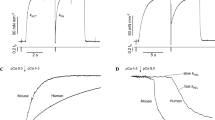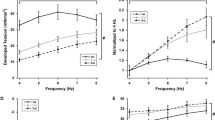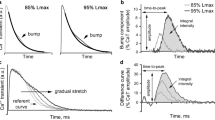Abstract
Human heart failure carries with it high mortal risks. The deficit in ventricular function results from a depression in power along with a blunting of the force-frequency relationship. Mechanical, myothermal and molecular biological analysis are used to uncover the mechanistic basis for the deficit in performance. At the cross-bridge level the average isometric force-time integral is increased in failing hearts. Despite this increase, the isometric peak force and rate of relaxation are markedly depressed and correlate with a substantial decrease in the amount and rate of calcium cycling per beat. The blunting of the force frequency relationship is shown to be directly related to the frequency dependence of the calcium concentration which in turn can be accounted for by alterations in the SERCA 2 calcium pump and the sarcolemmal Na/Ca exchange protein. There is a positive correlation between sarcoplasmic reticular calcium ATPase and frequency dependent changes in twitch tension and an inverse correlation between Na/Ca exchange protein and diastolic force. This analysis allows the hearts to be divided into two groups based on the Na/Ca exchange and SR calcium ATPase levels that separates the hearts that develop increased diastolic force from those that do not. In both groups of failing hearts the ratio of the Na/Ca exchange protein to the SERCA 2 pump is substantially increased. The phenotypic alterations in Na/Ca exchange protein, SERCA 2 calcium pump and the TnT isoform shift can account for the depression in power output and the associated ventricular dysfunction found in heart failure.
Similar content being viewed by others
References
Digitalis Intervention Group. The effect of digoxin on mortality and morbidity in patients with heart failure. N Eng J Med 1997;336:525–533.
LeWinter MM. An overview: Diabetic cardiomyopathy. Cor Art Dis 1996;7:94–98.
LeWinter MM, ed. Review in depth: Diabetic cardiomyopathy. Cor Art Dis 1996;7:94–142.
Katz AM. Influence of altered inotropy and lusitropy on ventricular pressure-volume loops. J Am Coll Cardiol 1988;11:438–445.
Hasenfuss G, Schillinger W, Lehnart SE, Preuss M, Pieske B, Maier LS, Prestle J, Minami K, Just H. Relationship between Na+-Ca2+-exchanger protein levels and diastolic dysfunction of failing human myocardium. Circulation 1999;99:641–648.
Topol EJ, Traill EA, Fortuin NJ, Hypertensive cardiomyopathy of the elderly. N Engl J Med 1985;312: 277–301.
Starling MR, Kirsh MM, Montgomery DG, Gross MD. Impaired left ventricular contractile function in patients with long-term mitral regurgitation and normal ejection fraction. J Am Coll Cardiol 1993;22:239–250.
Mulieri LA, Leavitt BJ, Hasenfuss G, Allen PD, Alpert NR. Myocardial force-frequency defect in mitral regurgitation heart failure is reversed by forskolin. Circulation 1993;88:2700–2704.
Gunther S, Grossman W. Determinants of ventricular function in pressure overload hypertrophy in man. Circulation 1979;59:679–688.
Grossman W, McLaurin LP, Moos SP, Stefadouros MA. Left ventricular stiffness associated with chronic pressure and volume overloads in man. Circ Res 1974;35:793–800.
Bache RJ, Arentzen CE, Simon AB, Vrobel TR. Abnormalities in myocardial perfusion during tachycardia in dogs with left ventricular hypertrophy: Metabolic evidence of ischemia. Circulation 1984;69:409–416.
Hasenfuss G, Reinecke H, Studer R, Meyer M, Pieske B, Holtz J, Holubarsch C, Posival H, Just H, Drexler H. Relation between myocardial function and expression of sarcoplasmic reticulum Ca2+-ATPase in failing and non-failing human myocardium. Circ Res 1994;75:434–442.
Feldman MD, Alderman JD, Aroesty JM, Royal HD, Ferguson JJ, Owen RM, Grossman W, McKay RG. Depression of systolic and diastolic myocardial reserve during atrial pacing tachycardia in humans with dilated cardiomyopathy. J Clin Invest 1988;82:1661–1669.
Rodeheffer RJ, Jacobson SJ, Gersh BJ, Kottke TE, McCann HA, Bailey KR, Ballard DJ. The incidence and revalence of heart failure in Rochester, Minnesota. Mayo Clin Proc 1993;68:1143–1150.
Cowie MR, Mostead A, Wood DA, Deckers JW, Poole-Wilson PA, Sutton GC, et al. The epidemiology of hear failure. Eur Heart J 1997;18:208–225.
The SOLVD Investigators. Effect of enalapril on survival in patients with reduced left ventricular ejection fractions and congestive heart failure. N Engl J Med 1991;325:293–302.
Califf RM, Adams KF, McKenna WJ, Gheorghiade M, Uretsky BF, McNulty SE, Darius H, Schulkman K, Zannad F, Handberg-Thurmond E, Harrell FE Jr, Wheeler W, Soler-Soler J, Swedberg K. A randomized controlled trial of epoprostenol therapy for severe congestive heart failure: The Flolan Internation Randomized Survival Trial (FIRST)/ A, Keart K 1997;134:44–54.
Cohn JN, Ziesche S, Smith R, Anand I, Dunkman WB, Loeb H, Cintron G, Boden W, Baruch L, Rochin P, Loss L. Effect of the calcium antagnist flodipine as supplementary vasodilator therapy in patients with chronic heart failure treated with enalapril: V-HeFT III. Vasodilator-Heart Filaure Trial (V-HeFT) Study Group. Circulation 1997;96(3):856–863.
Coulson RL. Energetics of isovolumic contractions of isolated rabbit heart. J Physiol 1976;260:45–53.
Gibbs CL, Gibson WR. Energy production of the rat soleus muscle. Am J Physiol 1976;223:864–871.
Hegland NC, Cavagna GA. Mechanical work, oxygen consumption and efficiency in isolated frog and rat muscle. Am J Physiol 1987;253:C22–C29.
Hill AV. The mechanical efficiency of frog muscle. Proc Roval Soc Ser B1939;127:434–451.
Wilkie DR. Thermodynamics and the interpretation of biological heat measurements. Prog Biophys Chem 1960;10:260–298.
Gibbs CL, Chapman JB. Cardiac energetics. In: Handbook of Physiology. The Cardiovascular System. Washington, DC: American Physiological Society, 1979:775–804.
Balaban RS. Regulation of oxidative phosphorylation in the mammalian cell. Am J Physiol 1990;258:C377–C389.
Woledge RC, Reilly PJ. Molar enthalpy changes for hydrolysis of phosphocreatine under conditions in muscle cells. Biophys J 1988;54:97–104.
Mulieri LA, Hasenfuss G, Ittleman F, Blanchard EM, Alpert NR. Protection of human left ventricular myocardium from cutting injury with 2, 3-butanedione monoxime. Circ Res 1989;65:1441–1449.
Hasenfuss G, Mulieri LA, Blanchard EM, Holubarsch CH, Leavitt BJ, Ittleman F, Alpert NR. Energetics of isometric force development in control and volume-overload human myocardium. Comparison with animal species. Circ Res 1991;68:836–846.
Mulieri LA, Luhr G, Trefry J, Alpert NR. Metal-film thermopiles for use with rabbit right ventricular papillary muscles. Am J Physiol 1977;233:C146–C156.
Hasenfuss G, Mulieri LA, Leavitt BJ, Allen PD, Haeberle JR, Alpert NR. Alteration of contractile function and excitation-contraction coupling in dilated cardiomyopathy. Circ Res 1992;70:1225–1232.
Alpert NR Blanchard EM, Mulieri LA. Tension-independent heat in rabbit papillary muscle. J Physiol 1989;414: 433–453.
Alpert NR, Gordon MS. Myofibrillar adenosine triphosphatase activity in congestive heart failure. Am J Physiol 1962;202:940–945.
Pagani ED, Alousi AA, Grant AM, Older TM, Dziuban SW Jr, Allen PD. Changes in myofibrillar content and Mg-ATPase activity in ventricular tissue from patients with heart failure caused by coronary artery disease, cardiomyopathy or mitral valve insufficiency. Circ Res 1988;63:380–385.
Harris D, Work SS, Wright RK, Alpert NR, Warshaw DM. Smooth, cardiac and skeletal muscle myosin force and motion generation by cross-bridge mechanical interactions in vitro. J Molec Res Cell Motility 1994;15:11–19.
Anderson PAW, Grieg A, Mark TM, Malouf NN, Oakeley AE, Ungerlieder RM, Allen PD, Kay BK. Molecular basis for human cardiac troponin T isoform in the developing, adult and failing heart. Circ Res 1995;76:681–686.
Mesnard L, Logeart D, Taviaux S, Diriong S, Mercadier JJ, Samson G. Human cardiac troponin T. Clojning and expression of new isoforms in normal and failing heart. Circ Res 1995;76:687–692.
Pieske B, Kretschmann B, Meyer M, Holubarsch C, Weirich J, Posival H, Minami K, Just H, Hasenfuss G. Alterations in intracellular calcium handling associated with the inverse force-frequency relation in human dilated cardiomyopathy. Circulation 1995;92:1169–1178.
Pieske B, Sutterlin M, Schmidt-Schweda S, Minami K, Meyer M, Olschewski M, Holubarsch C, Just H, Hasenfuss G. Diminished post-rest potentiation of contractile force in human dilated cardiomyopathy. Functional evidence for alterations in intracellular Ca2+ handling. J Clin Invest 1996;98:764–776.
Pieske B, Maier LS, Bers DM, Hasenfuss G. Ca2+ handling and sarcoplasmic reticulum Ca2+ content in isolated failing and non-failing human myocardium. Circ Res 1999;85:38–46.
Beuckelmann DJ, Erdmann E. Ca2+-currents and intracellular [Ca2+]i-transients in single ventricular myocytes isolated from terminally failing human myocardium. Basic Res Cardiol 1992;87(Suppl 1):235–243.
Piot C, Lemaire S, Albat B, Seguin J, Nargeot J, Richard S. High frequency-induced upregulation of human cardiac calcium currents. Circulation 1996;93:120–128.
Hasenfuss G. Alterations of calcium-regulatory proteins in heart failure. Cardiovasc Res 1998;37:279–289.
Bers DM, Christensen DM, Nguyen TX. Can Ca2+ entry via Na+-Ca2+ exchange directly activate cardiacmuscle contraction? J Mol Cell Cardiol 1988;20:405–414.
Flesch M, Schwinger RH, Schiffer F, Frank K, Sudkamp M, Kuhn-Regnier F, Arnold G, Bohm M. Evidence for functional relevance of an enhanced expression of the Na+-Ca2+ exchanger in failing human myocardium. Circulation 1996;94:992–1002.
Limas CJ, Olivari MT, Goldenberg IF, Levine TB, Benditt DG, Simon A. Calcium uptake by cardiac sarcoplasmic reticulum in human dilated cardiomyopathy. Cardiovasc Res 1987;21:601–605.
Reinecke H, Studer R, Vetter R, Holtz J, Drexler H. Cardiac Na+/Ca2+ exchange activity in patients with end-stage heart failure. Cardiovasc Res 1996;31:48–54.
Schwinger RH, Bohm M, Schmidt U, Karczewski P, Bavendiek U, Flesch M, Krause EG, Erdmann E. Unchanged protein levels of SERCA II and phospholamban but reduced Ca2+ uptake and Ca2+-ATPase activity of cardiac sarcoplasmic reticulum from dilated cardiomyopathy patients compared with patients with non-failing hearts. Circulation 1995;92:3220–3228.
Studer R, Reinecke H, Bilger J, Eschenhagen T, Bohm M, Hasenfuss G, Just H, Holtz J, Drexler H. Gene expression of the cardiac Na+-Ca2+ exchanger in end-stage human heart failure. Circ Res 1994;75:443–453.
Movsesian MA, Karimi M, Green K, Jones LR. Ca2+-transporting ATPase, phospholamban, and calsequestrin levels in nonfailing and failing human myocardium. Circulation 1994;90:653–657.
Kranias EG, Garvey JL, Srivastava RD, Solaro RJ. Phosphorylation and functional modifications of sarcoplasmic reticulum and myofibrils in isolated rabbit hearts stimulated with isoprenaline. Biochem J 1985;226:113–121.
Voss J, Jones LR, Thomas DD. The physical mechanism of calcium pump regulation in the heart. Biophys J 1994;67: 190–196
Author information
Authors and Affiliations
Rights and permissions
About this article
Cite this article
Alpert, N.R., LeWinter, M., Mulieri, L.A. et al. Chemomechanical Energy Transduction in the Failing Heart. Heart Fail Rev 4, 281–295 (1999). https://doi.org/10.1023/A:1009818225222
Issue Date:
DOI: https://doi.org/10.1023/A:1009818225222




